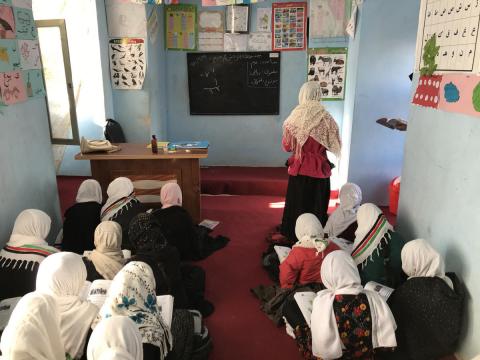Why women and girls always bear the brunt of crisis

By Asuntha Charles, National Director of World Vision Afghanistan
At the start of 2020, the world was poised to celebrate some incredible gender wins. Compared to 25 years ago, girls were twice as likely to survive beyond the age of five. The gender gap in schools was visibly shrinking – here in Afghanistan four in every 10 girls went to primary school whereas twenty years ago, it was almost zero.
However, as the world watched a humanitarian crisis unfold in Afghanistan recently, I was reminded, as I have been throughout my humanitarian career, that no matter the crisis, women and girls always bear the brunt. Sadly, when crisis hits, progress for girls often hangs in the balance.
We watched this play out with COVID-19 as women all over the globe left the workforce in significantly higher numbers to shoulder the burden of care and household responsibilities. In developing countries, we know that millions of children, who were enrolled in school before the pandemic, may never return. Evidence suggests the majority of those will be girls with 11 million unlikely to set foot in a classroom again.
A similar scenario is playing out with the growing hunger crisis. As millions stand on the precipice of famine, we know that the biggest victims will be women and children because our experience shows that when food is scarce women and girls eat last, least or not at all.
Women and girls suffer disproportionately during crisis because existing inequalities are exacerbated and traditional systems to protect them break down.
So what can we do? No matter the country, crises seem inevitable in some way or another. But that doesn’t mean hope for vulnerable women and girls has to be lost.
I know this hope personally. Raised in a traditional south Asian family in a traditional society, I had to fight for my dreams while enduring mounting pressure from friends and family to get married and start a family. I chose to defy the norm and became the first woman in my family to travel abroad and live independently.
My journey took me to Afghanistan, where I climbed through the ranks to become the female leader of one of the largest NGOs operating in another very conservative context.
I’m not alone. I know the incredible potential that can be unlocked in girls when they are supported.
Take Hirdesh for example. She is a school principal in my home country. However, it is unlikely that she would have even graduated primary school had she not been sponsored.
With her village only offering schooling up to the fifth grade and girls being married at 14, her dream of attending college was a distant fantasy. That was until 2002, when someone decided to sponsor Hirdesh, enabling her to attend school in a nearby village. Sponsorship didn’t just help Hirdesh break through the barriers of patriarchy, but her entire village too. Sponsorship meant that World Vision could host community trainings on the harms of child marriage and the benefits of keeping girls in school. When Hirdesh applied to teacher training college she did it in secret from her parents, but when she was accepted it was her parents who agreed she could attend, because their mindsets on the role of women had shifted. Today Hirdesh runs a school of 117 children and holds a masters degree in psychology.
In more fragile countries, like here in Afghanistan, sponsorship isn’t possible due to instability and conflict. But this doesn’t mean girls have to miss out. Thanks to ongoing support from donors, the expansion in access to education over recent years has led to a huge growth in capability, especially among girls, who are now becoming doctors and teachers and more. We must not allow things to go backwards.
No matter the country, girls everywhere hold unique potential to close gender gaps and drive sustainable change in the future. Not investing in their protection, education and well-being would be a failure.
It’s not too late to protect a generation of progress by donating or sponsoring a girl today.